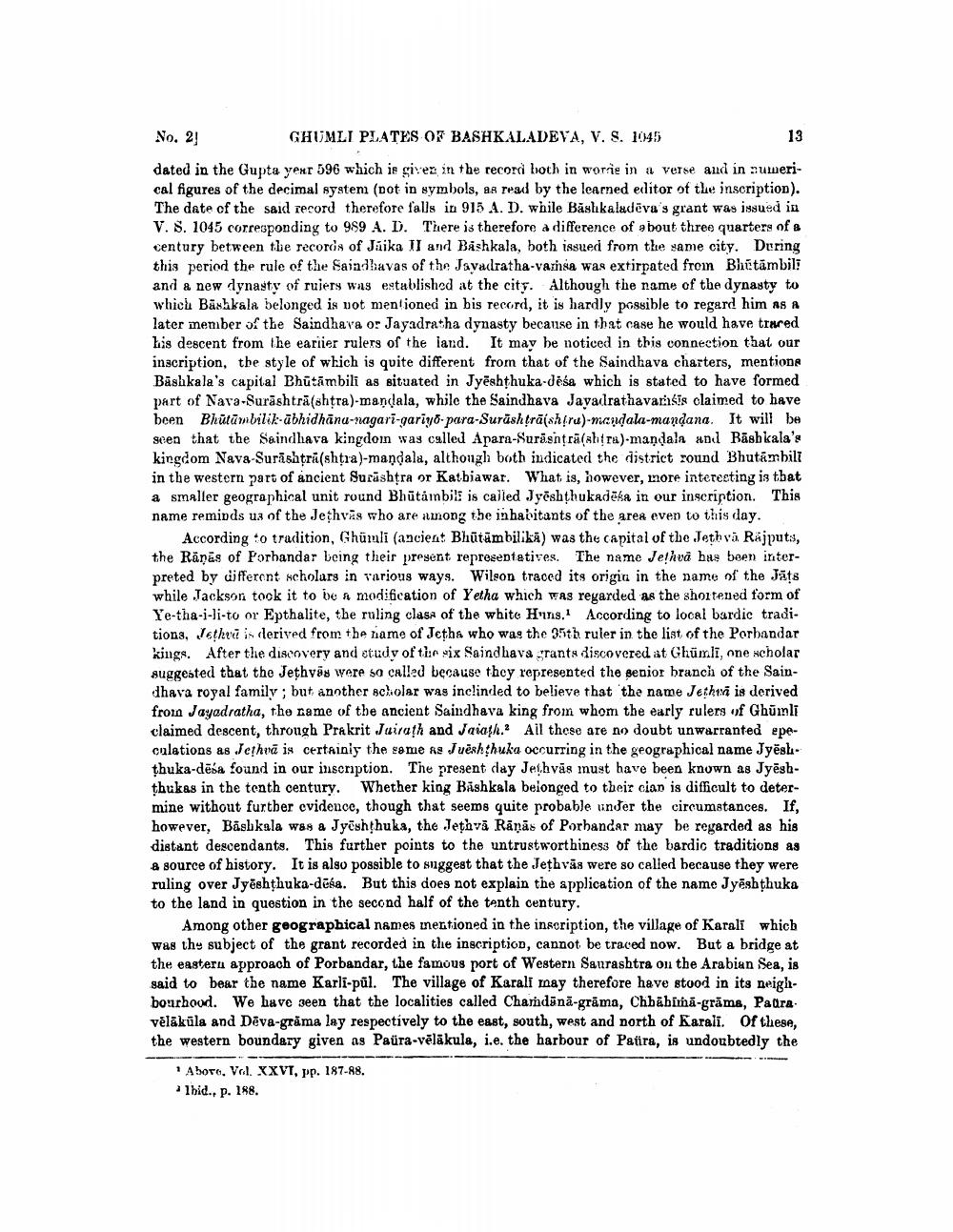________________
No. 21
GHUMLI PLATES OF BASHKALADEVA, V. S. 1045
dated in the Gupta year 596 which is given in the record both in wors in a verse and in numerical figures of the decimal system (not in symbols, as read by the learned editor of the inscription). The date of the said record therefore falls in 915 A. D. while Bashkaladeva's grant was issued in V. S. 1045 corresponding to 989 A. D. There is therefore a difference of about three quarters of a century between the records of Jaika II and Bashkala, both issued from the same city. During this period the rule of the Saindhavas of the Jayadratha-vamsa was extirpated from Bhutambil! and a new dynasty of rulers was established at the city. Although the name of the dynasty to which Bashkala belonged is not mentioned in his record, it is hardly possible to regard him as a later member of the Saindhava or Jayadratha dynasty because in that case he would have traced his descent from the eariier rulers of the land. It may be noticed in this connection that our inscription, the style of which is quite different from that of the Saindhava charters, mentions Bashkala's capital Bhūtāmbili as situated in Jyeshthuka-desa which is stated to have formed part of Nava-Surashtra (shtra)-mandala, while the Saindhava Jayadrathavarsis claimed to have been Bhutūmbilik abhidhana-nagari-gariyo-para-Surashtra(shtra)-mandala-mandana. It will be seen that the Saindhava kingdom was called Apara-Surashtra (shtra)-mandala and Bashkala's kingdom Nava-Surashtra (shtra)-maṇḍala, although both indicated the district round Bhutambili in the western part of ancient Surashtra or Kathiawar. What is, however, more interesting is that a smaller geographical unit round Bhutámbili is called Jyeshthukadeka in our inscription. This name reminds us of the Jethvas who are among the inhabitants of the area even to this day.
13
According to tradition, Ghümli (ancient Bhūtāmbilika) was the capital of the Jethvi Rajputs, the Ranās of Forbandar being their present representatives. The name Jethea has been interpreted by different scholars in various ways. Wilson traced its origia in the name of the Jāts while Jackson tock it to be a modification of Yetha which was regarded as the shortened form of Ye-tha-i-li-to or Epthalite, the ruling class of the white Huns. According to local bardic traditions, Jetha is derived from the name of Jetha who was the 35th ruler in the list of the Porbandar kings. After the discovery and study of the six Saindhava grants discovered at Ghümli, one scholar suggested that the Jethvas were so called because they represented the senior branch of the Saindhava royal family; but another scholar was inclinded to believe that the name Jetha is derived from Jayadratha, the name of the ancient Saindhava king from whom the early rulers of Ghumli claimed descent, through Prakrit Jairath and Jaiath. All these are no doubt unwarranted epeculations as Jethva is certainly the same as Jueshthuka occurring in the geographical name Jyësh. thuka-desa found in our inscription. The present day Jethvas must have been known as Jyēshthukas in the tenth century. Whether king Bashkala belonged to their cian is difficult to determine without further evidence, though that seems quite probable under the circumstances. If, however, Bashkala was a Jyeshthuka, the Jethva Rāņas of Porbandar may be regarded as his distant descendants. This further points to the untrustworthiness of the bardic traditions as a source of history. It is also possible to suggest that the Jethvas were so called because they were ruling over Jyeshthuka-desa. But this does not explain the application of the name Jyeshthuka to the land in question in the second half of the tenth century.
Among other geographical names mentioned in the inscription, the village of Karali which was the subject of the grant recorded in the inscription, cannot be traced now. But a bridge at the eastern approach of Porbandar, the famous port of Western Saurashtra on the Arabian Sea, is said to bear the name Karli-pul. The village of Karali may therefore have stood in its neighbourhood. We have seen that the localities called Chamdana-grāma, Chhāhīmā-grāma, Pauravēlāküla and Deva-grāma lay respectively to the east, south, west and north of Karali. Of these, the western boundary given as Paüra-vēlākula, i.e. the harbour of Paüra, is undoubtedly the
Above, Vol. XXVI, pp. 187-88.
Ibid., p. 188.




